Research Methodology Plan: Ethical Leadership in K-12 Private Schools
VerifiedAdded on 2022/11/10
|11
|2654
|256
Report
AI Summary
This report presents a detailed methodology plan for a research study investigating K-12 students' perceptions of ethical and servant leadership behaviors in a private school setting. The study aims to build upon existing research, utilizing the Ethical Leadership Scale (ELS) and a validated instrument to assess servant leadership. The research design will employ a descriptive approach, collecting qualitative data through student responses. The target population consists of K-12 students, with a sample size of 500 students selected using simple random sampling. Data collection involves questionnaires and interviews exploring students' views on ethical leadership dimensions such as communication, decision-making, behavior, and climate. The study will also examine the relationship between ethical and servant leadership, adding research questions and hypotheses to compare the two leadership styles. Data analysis will involve descriptive statistics, t-tests, and qualitative analysis of open-ended responses. Ethical considerations and potential limitations are also addressed in this comprehensive research plan.
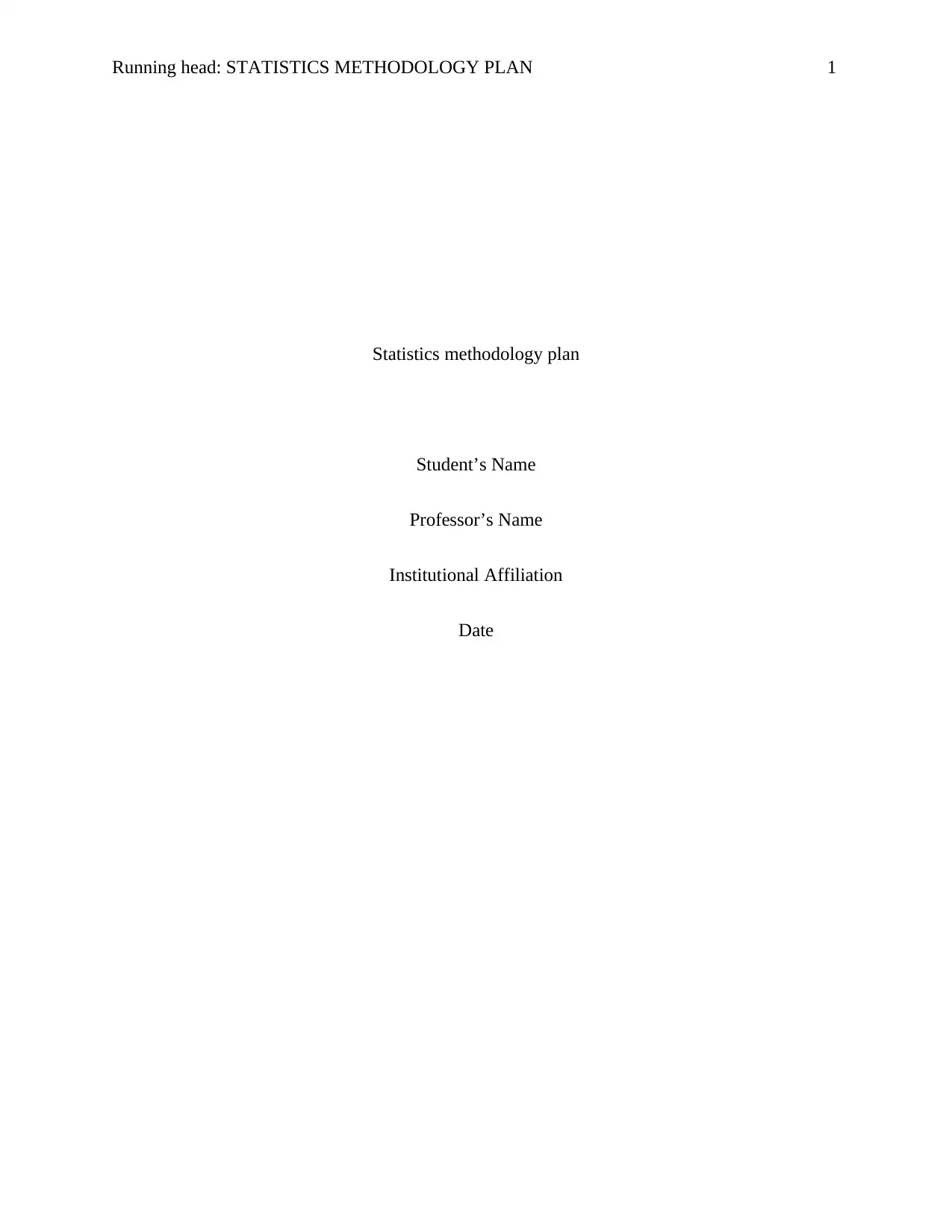
Running head: STATISTICS METHODOLOGY PLAN 1
Statistics methodology plan
Student’s Name
Professor’s Name
Institutional Affiliation
Date
Statistics methodology plan
Student’s Name
Professor’s Name
Institutional Affiliation
Date
Paraphrase This Document
Need a fresh take? Get an instant paraphrase of this document with our AI Paraphraser
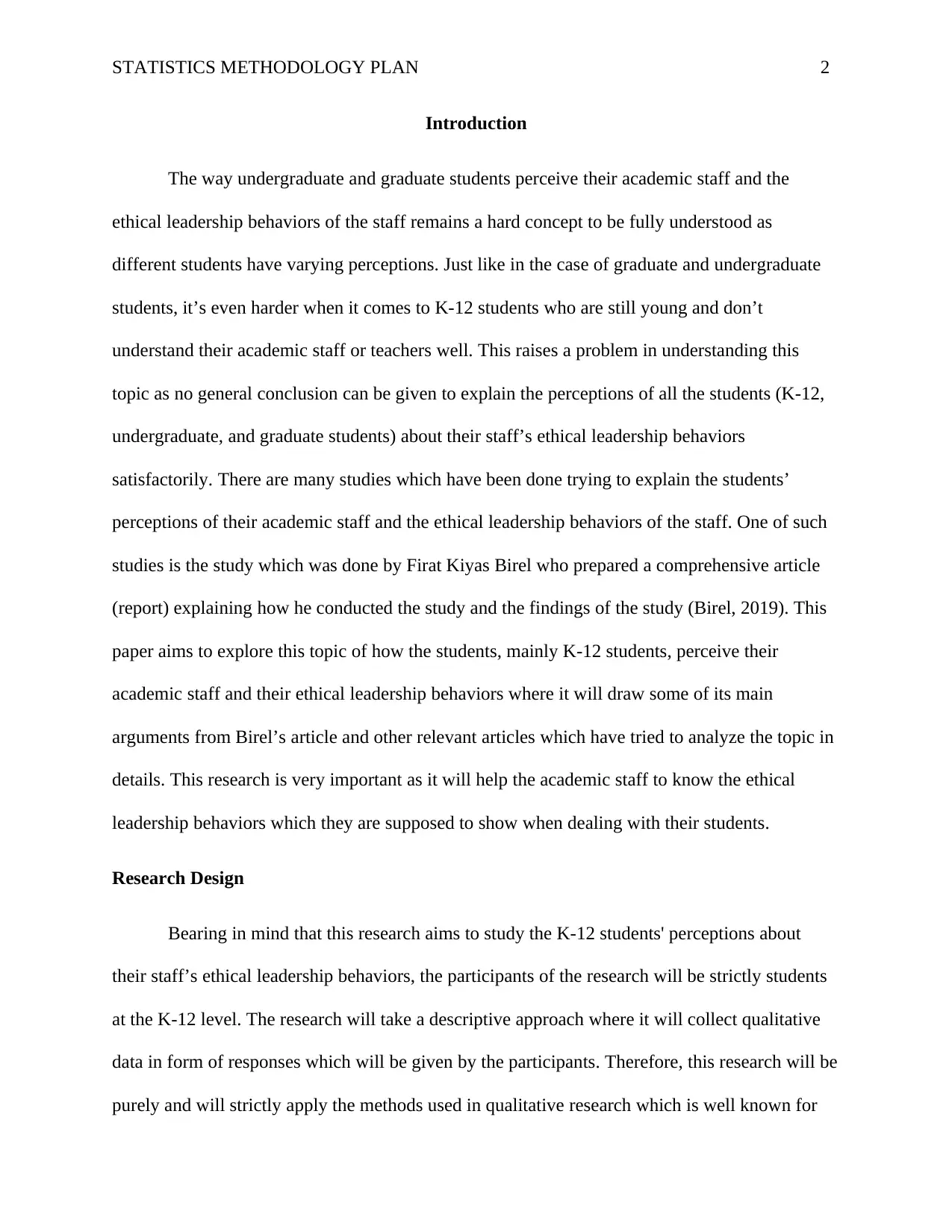
STATISTICS METHODOLOGY PLAN 2
Introduction
The way undergraduate and graduate students perceive their academic staff and the
ethical leadership behaviors of the staff remains a hard concept to be fully understood as
different students have varying perceptions. Just like in the case of graduate and undergraduate
students, it’s even harder when it comes to K-12 students who are still young and don’t
understand their academic staff or teachers well. This raises a problem in understanding this
topic as no general conclusion can be given to explain the perceptions of all the students (K-12,
undergraduate, and graduate students) about their staff’s ethical leadership behaviors
satisfactorily. There are many studies which have been done trying to explain the students’
perceptions of their academic staff and the ethical leadership behaviors of the staff. One of such
studies is the study which was done by Firat Kiyas Birel who prepared a comprehensive article
(report) explaining how he conducted the study and the findings of the study (Birel, 2019). This
paper aims to explore this topic of how the students, mainly K-12 students, perceive their
academic staff and their ethical leadership behaviors where it will draw some of its main
arguments from Birel’s article and other relevant articles which have tried to analyze the topic in
details. This research is very important as it will help the academic staff to know the ethical
leadership behaviors which they are supposed to show when dealing with their students.
Research Design
Bearing in mind that this research aims to study the K-12 students' perceptions about
their staff’s ethical leadership behaviors, the participants of the research will be strictly students
at the K-12 level. The research will take a descriptive approach where it will collect qualitative
data in form of responses which will be given by the participants. Therefore, this research will be
purely and will strictly apply the methods used in qualitative research which is well known for
Introduction
The way undergraduate and graduate students perceive their academic staff and the
ethical leadership behaviors of the staff remains a hard concept to be fully understood as
different students have varying perceptions. Just like in the case of graduate and undergraduate
students, it’s even harder when it comes to K-12 students who are still young and don’t
understand their academic staff or teachers well. This raises a problem in understanding this
topic as no general conclusion can be given to explain the perceptions of all the students (K-12,
undergraduate, and graduate students) about their staff’s ethical leadership behaviors
satisfactorily. There are many studies which have been done trying to explain the students’
perceptions of their academic staff and the ethical leadership behaviors of the staff. One of such
studies is the study which was done by Firat Kiyas Birel who prepared a comprehensive article
(report) explaining how he conducted the study and the findings of the study (Birel, 2019). This
paper aims to explore this topic of how the students, mainly K-12 students, perceive their
academic staff and their ethical leadership behaviors where it will draw some of its main
arguments from Birel’s article and other relevant articles which have tried to analyze the topic in
details. This research is very important as it will help the academic staff to know the ethical
leadership behaviors which they are supposed to show when dealing with their students.
Research Design
Bearing in mind that this research aims to study the K-12 students' perceptions about
their staff’s ethical leadership behaviors, the participants of the research will be strictly students
at the K-12 level. The research will take a descriptive approach where it will collect qualitative
data in form of responses which will be given by the participants. Therefore, this research will be
purely and will strictly apply the methods used in qualitative research which is well known for
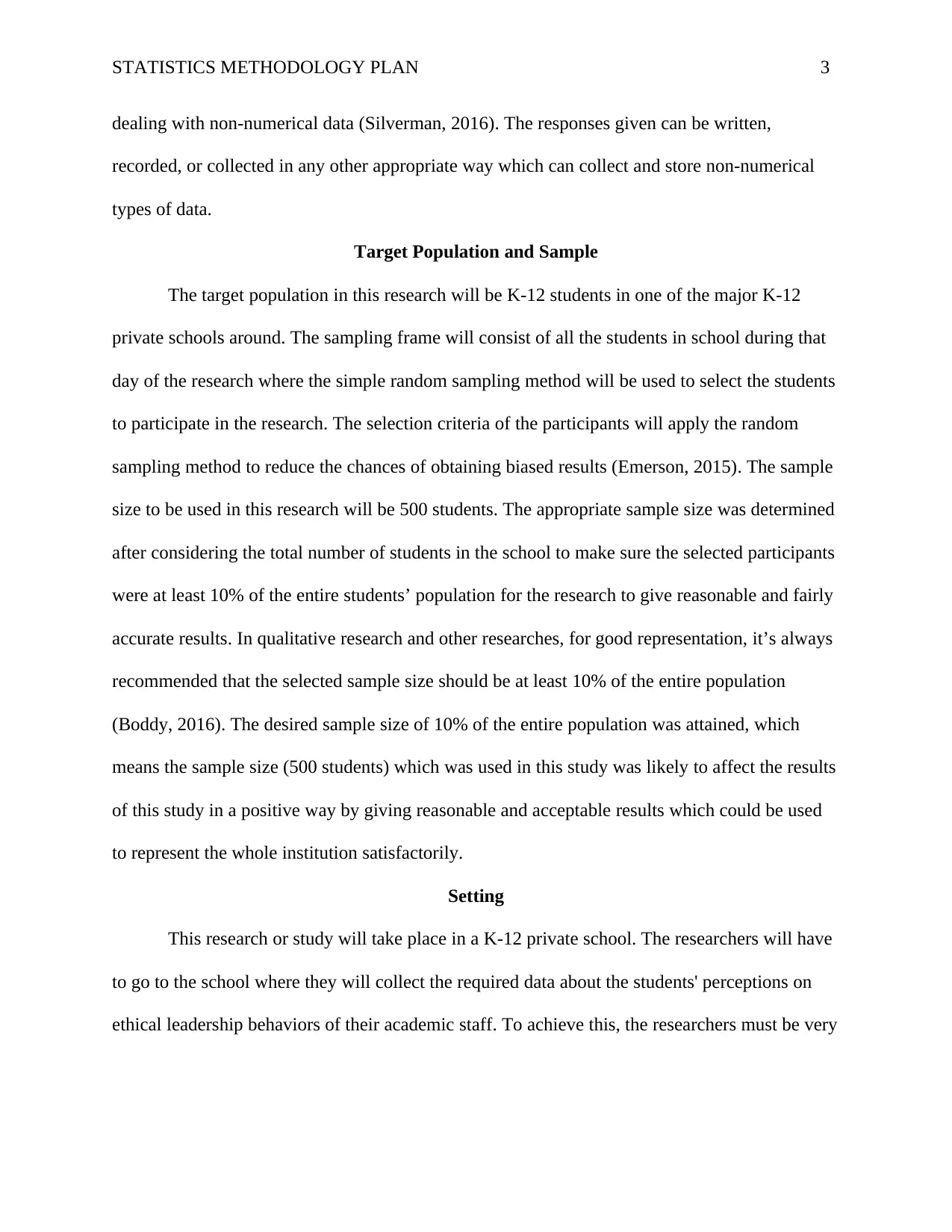
STATISTICS METHODOLOGY PLAN 3
dealing with non-numerical data (Silverman, 2016). The responses given can be written,
recorded, or collected in any other appropriate way which can collect and store non-numerical
types of data.
Target Population and Sample
The target population in this research will be K-12 students in one of the major K-12
private schools around. The sampling frame will consist of all the students in school during that
day of the research where the simple random sampling method will be used to select the students
to participate in the research. The selection criteria of the participants will apply the random
sampling method to reduce the chances of obtaining biased results (Emerson, 2015). The sample
size to be used in this research will be 500 students. The appropriate sample size was determined
after considering the total number of students in the school to make sure the selected participants
were at least 10% of the entire students’ population for the research to give reasonable and fairly
accurate results. In qualitative research and other researches, for good representation, it’s always
recommended that the selected sample size should be at least 10% of the entire population
(Boddy, 2016). The desired sample size of 10% of the entire population was attained, which
means the sample size (500 students) which was used in this study was likely to affect the results
of this study in a positive way by giving reasonable and acceptable results which could be used
to represent the whole institution satisfactorily.
Setting
This research or study will take place in a K-12 private school. The researchers will have
to go to the school where they will collect the required data about the students' perceptions on
ethical leadership behaviors of their academic staff. To achieve this, the researchers must be very
dealing with non-numerical data (Silverman, 2016). The responses given can be written,
recorded, or collected in any other appropriate way which can collect and store non-numerical
types of data.
Target Population and Sample
The target population in this research will be K-12 students in one of the major K-12
private schools around. The sampling frame will consist of all the students in school during that
day of the research where the simple random sampling method will be used to select the students
to participate in the research. The selection criteria of the participants will apply the random
sampling method to reduce the chances of obtaining biased results (Emerson, 2015). The sample
size to be used in this research will be 500 students. The appropriate sample size was determined
after considering the total number of students in the school to make sure the selected participants
were at least 10% of the entire students’ population for the research to give reasonable and fairly
accurate results. In qualitative research and other researches, for good representation, it’s always
recommended that the selected sample size should be at least 10% of the entire population
(Boddy, 2016). The desired sample size of 10% of the entire population was attained, which
means the sample size (500 students) which was used in this study was likely to affect the results
of this study in a positive way by giving reasonable and acceptable results which could be used
to represent the whole institution satisfactorily.
Setting
This research or study will take place in a K-12 private school. The researchers will have
to go to the school where they will collect the required data about the students' perceptions on
ethical leadership behaviors of their academic staff. To achieve this, the researchers must be very
⊘ This is a preview!⊘
Do you want full access?
Subscribe today to unlock all pages.

Trusted by 1+ million students worldwide
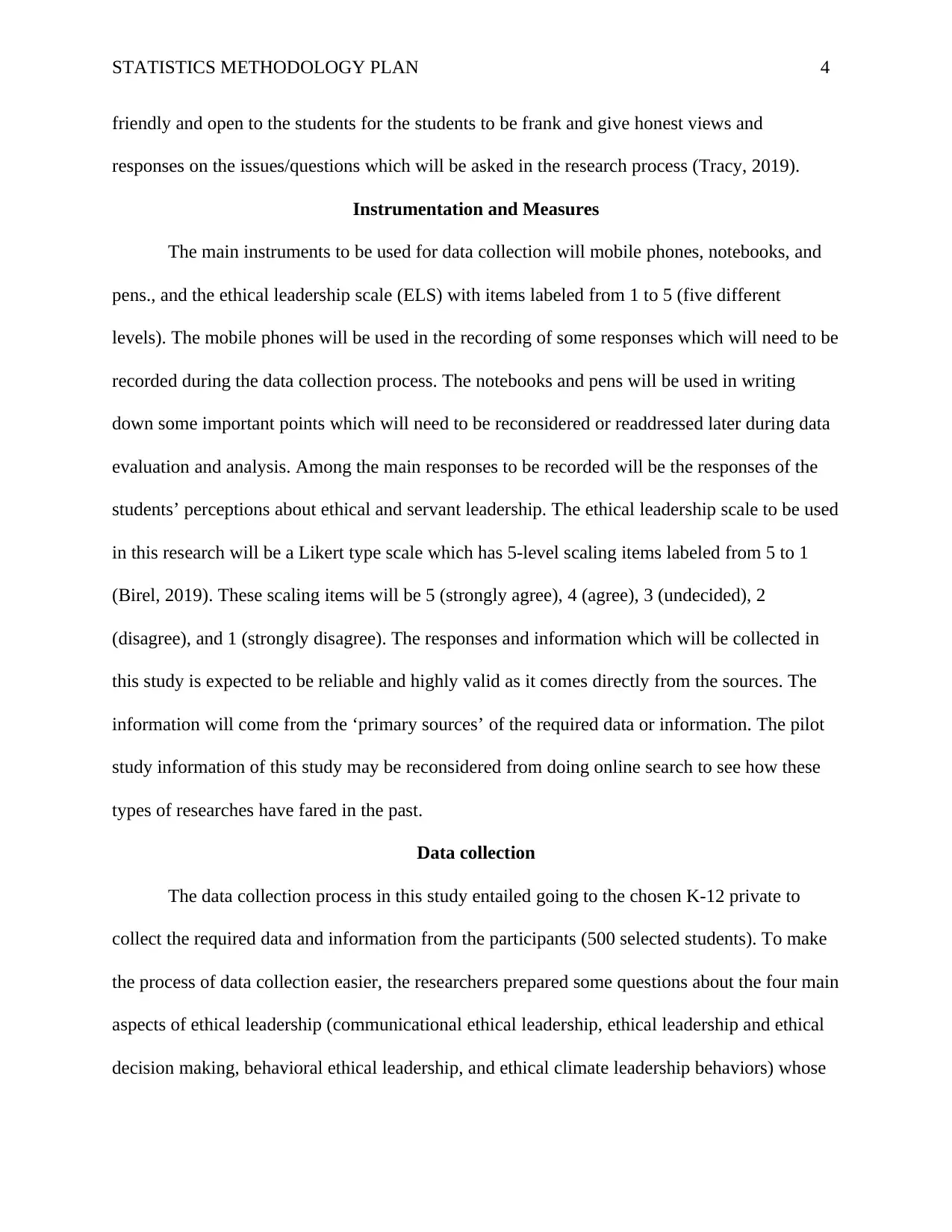
STATISTICS METHODOLOGY PLAN 4
friendly and open to the students for the students to be frank and give honest views and
responses on the issues/questions which will be asked in the research process (Tracy, 2019).
Instrumentation and Measures
The main instruments to be used for data collection will mobile phones, notebooks, and
pens., and the ethical leadership scale (ELS) with items labeled from 1 to 5 (five different
levels). The mobile phones will be used in the recording of some responses which will need to be
recorded during the data collection process. The notebooks and pens will be used in writing
down some important points which will need to be reconsidered or readdressed later during data
evaluation and analysis. Among the main responses to be recorded will be the responses of the
students’ perceptions about ethical and servant leadership. The ethical leadership scale to be used
in this research will be a Likert type scale which has 5-level scaling items labeled from 5 to 1
(Birel, 2019). These scaling items will be 5 (strongly agree), 4 (agree), 3 (undecided), 2
(disagree), and 1 (strongly disagree). The responses and information which will be collected in
this study is expected to be reliable and highly valid as it comes directly from the sources. The
information will come from the ‘primary sources’ of the required data or information. The pilot
study information of this study may be reconsidered from doing online search to see how these
types of researches have fared in the past.
Data collection
The data collection process in this study entailed going to the chosen K-12 private to
collect the required data and information from the participants (500 selected students). To make
the process of data collection easier, the researchers prepared some questions about the four main
aspects of ethical leadership (communicational ethical leadership, ethical leadership and ethical
decision making, behavioral ethical leadership, and ethical climate leadership behaviors) whose
friendly and open to the students for the students to be frank and give honest views and
responses on the issues/questions which will be asked in the research process (Tracy, 2019).
Instrumentation and Measures
The main instruments to be used for data collection will mobile phones, notebooks, and
pens., and the ethical leadership scale (ELS) with items labeled from 1 to 5 (five different
levels). The mobile phones will be used in the recording of some responses which will need to be
recorded during the data collection process. The notebooks and pens will be used in writing
down some important points which will need to be reconsidered or readdressed later during data
evaluation and analysis. Among the main responses to be recorded will be the responses of the
students’ perceptions about ethical and servant leadership. The ethical leadership scale to be used
in this research will be a Likert type scale which has 5-level scaling items labeled from 5 to 1
(Birel, 2019). These scaling items will be 5 (strongly agree), 4 (agree), 3 (undecided), 2
(disagree), and 1 (strongly disagree). The responses and information which will be collected in
this study is expected to be reliable and highly valid as it comes directly from the sources. The
information will come from the ‘primary sources’ of the required data or information. The pilot
study information of this study may be reconsidered from doing online search to see how these
types of researches have fared in the past.
Data collection
The data collection process in this study entailed going to the chosen K-12 private to
collect the required data and information from the participants (500 selected students). To make
the process of data collection easier, the researchers prepared some questions about the four main
aspects of ethical leadership (communicational ethical leadership, ethical leadership and ethical
decision making, behavioral ethical leadership, and ethical climate leadership behaviors) whose
Paraphrase This Document
Need a fresh take? Get an instant paraphrase of this document with our AI Paraphraser
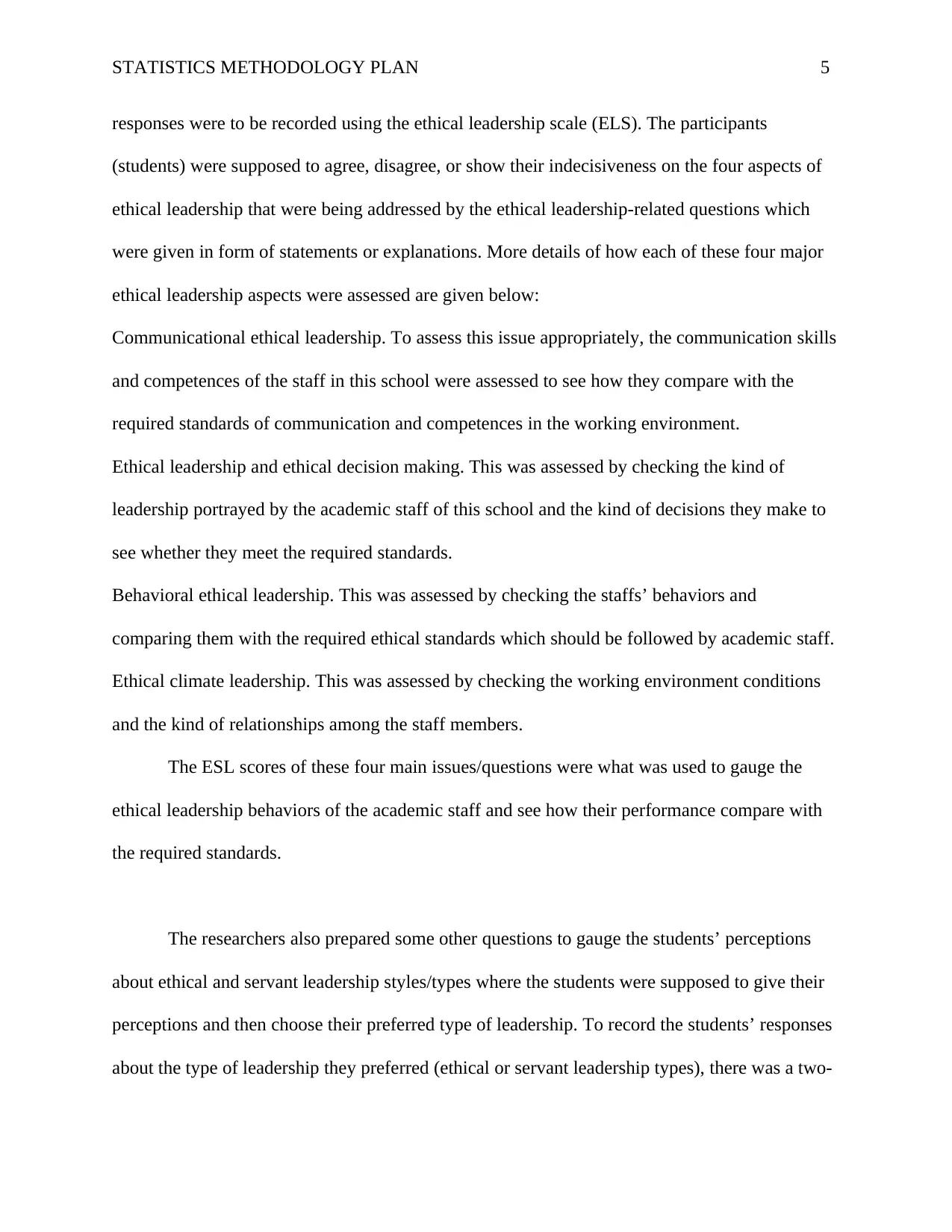
STATISTICS METHODOLOGY PLAN 5
responses were to be recorded using the ethical leadership scale (ELS). The participants
(students) were supposed to agree, disagree, or show their indecisiveness on the four aspects of
ethical leadership that were being addressed by the ethical leadership-related questions which
were given in form of statements or explanations. More details of how each of these four major
ethical leadership aspects were assessed are given below:
Communicational ethical leadership. To assess this issue appropriately, the communication skills
and competences of the staff in this school were assessed to see how they compare with the
required standards of communication and competences in the working environment.
Ethical leadership and ethical decision making. This was assessed by checking the kind of
leadership portrayed by the academic staff of this school and the kind of decisions they make to
see whether they meet the required standards.
Behavioral ethical leadership. This was assessed by checking the staffs’ behaviors and
comparing them with the required ethical standards which should be followed by academic staff.
Ethical climate leadership. This was assessed by checking the working environment conditions
and the kind of relationships among the staff members.
The ESL scores of these four main issues/questions were what was used to gauge the
ethical leadership behaviors of the academic staff and see how their performance compare with
the required standards.
The researchers also prepared some other questions to gauge the students’ perceptions
about ethical and servant leadership styles/types where the students were supposed to give their
perceptions and then choose their preferred type of leadership. To record the students’ responses
about the type of leadership they preferred (ethical or servant leadership types), there was a two-
responses were to be recorded using the ethical leadership scale (ELS). The participants
(students) were supposed to agree, disagree, or show their indecisiveness on the four aspects of
ethical leadership that were being addressed by the ethical leadership-related questions which
were given in form of statements or explanations. More details of how each of these four major
ethical leadership aspects were assessed are given below:
Communicational ethical leadership. To assess this issue appropriately, the communication skills
and competences of the staff in this school were assessed to see how they compare with the
required standards of communication and competences in the working environment.
Ethical leadership and ethical decision making. This was assessed by checking the kind of
leadership portrayed by the academic staff of this school and the kind of decisions they make to
see whether they meet the required standards.
Behavioral ethical leadership. This was assessed by checking the staffs’ behaviors and
comparing them with the required ethical standards which should be followed by academic staff.
Ethical climate leadership. This was assessed by checking the working environment conditions
and the kind of relationships among the staff members.
The ESL scores of these four main issues/questions were what was used to gauge the
ethical leadership behaviors of the academic staff and see how their performance compare with
the required standards.
The researchers also prepared some other questions to gauge the students’ perceptions
about ethical and servant leadership styles/types where the students were supposed to give their
perceptions and then choose their preferred type of leadership. To record the students’ responses
about the type of leadership they preferred (ethical or servant leadership types), there was a two-
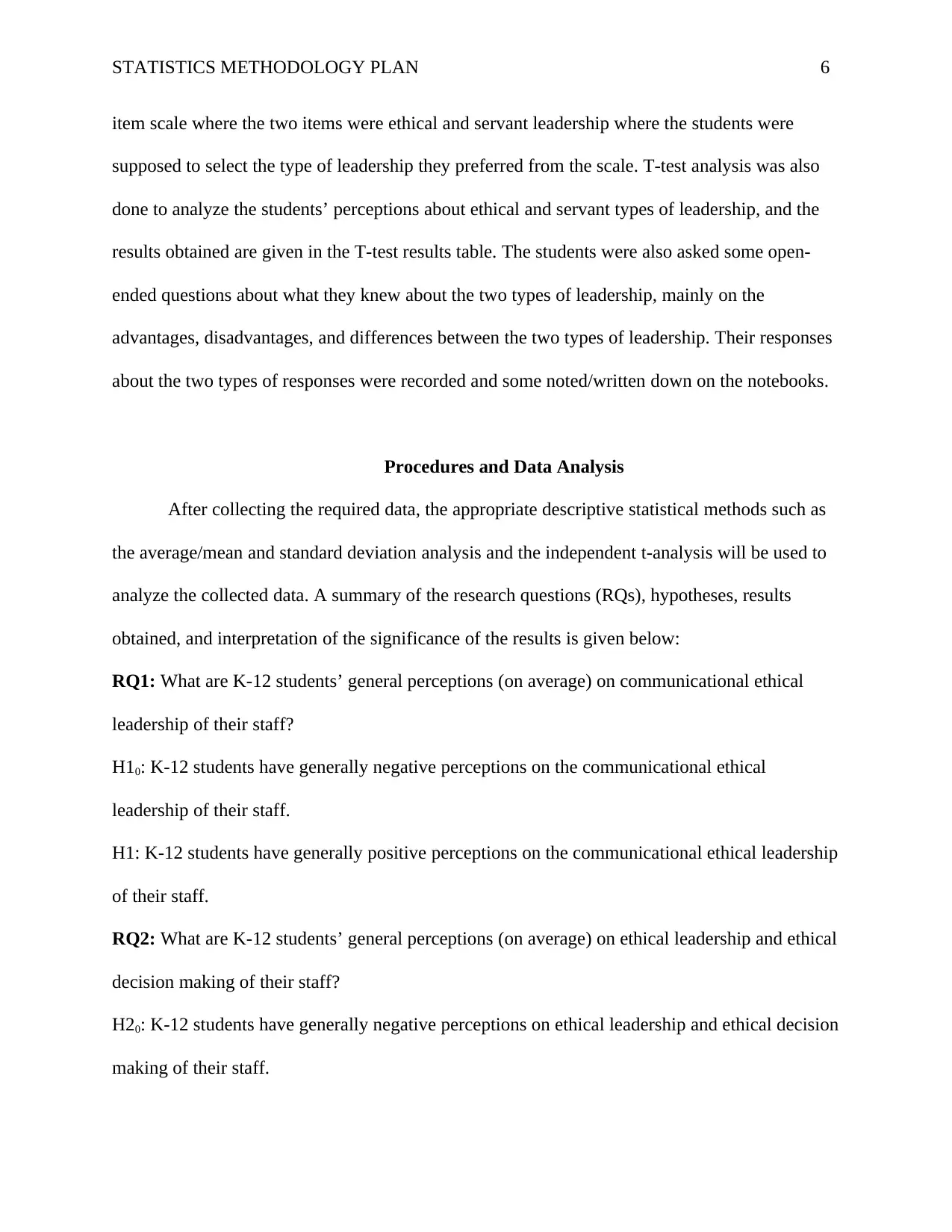
STATISTICS METHODOLOGY PLAN 6
item scale where the two items were ethical and servant leadership where the students were
supposed to select the type of leadership they preferred from the scale. T-test analysis was also
done to analyze the students’ perceptions about ethical and servant types of leadership, and the
results obtained are given in the T-test results table. The students were also asked some open-
ended questions about what they knew about the two types of leadership, mainly on the
advantages, disadvantages, and differences between the two types of leadership. Their responses
about the two types of responses were recorded and some noted/written down on the notebooks.
Procedures and Data Analysis
After collecting the required data, the appropriate descriptive statistical methods such as
the average/mean and standard deviation analysis and the independent t-analysis will be used to
analyze the collected data. A summary of the research questions (RQs), hypotheses, results
obtained, and interpretation of the significance of the results is given below:
RQ1: What are K-12 students’ general perceptions (on average) on communicational ethical
leadership of their staff?
H10: K-12 students have generally negative perceptions on the communicational ethical
leadership of their staff.
H1: K-12 students have generally positive perceptions on the communicational ethical leadership
of their staff.
RQ2: What are K-12 students’ general perceptions (on average) on ethical leadership and ethical
decision making of their staff?
H20: K-12 students have generally negative perceptions on ethical leadership and ethical decision
making of their staff.
item scale where the two items were ethical and servant leadership where the students were
supposed to select the type of leadership they preferred from the scale. T-test analysis was also
done to analyze the students’ perceptions about ethical and servant types of leadership, and the
results obtained are given in the T-test results table. The students were also asked some open-
ended questions about what they knew about the two types of leadership, mainly on the
advantages, disadvantages, and differences between the two types of leadership. Their responses
about the two types of responses were recorded and some noted/written down on the notebooks.
Procedures and Data Analysis
After collecting the required data, the appropriate descriptive statistical methods such as
the average/mean and standard deviation analysis and the independent t-analysis will be used to
analyze the collected data. A summary of the research questions (RQs), hypotheses, results
obtained, and interpretation of the significance of the results is given below:
RQ1: What are K-12 students’ general perceptions (on average) on communicational ethical
leadership of their staff?
H10: K-12 students have generally negative perceptions on the communicational ethical
leadership of their staff.
H1: K-12 students have generally positive perceptions on the communicational ethical leadership
of their staff.
RQ2: What are K-12 students’ general perceptions (on average) on ethical leadership and ethical
decision making of their staff?
H20: K-12 students have generally negative perceptions on ethical leadership and ethical decision
making of their staff.
⊘ This is a preview!⊘
Do you want full access?
Subscribe today to unlock all pages.

Trusted by 1+ million students worldwide
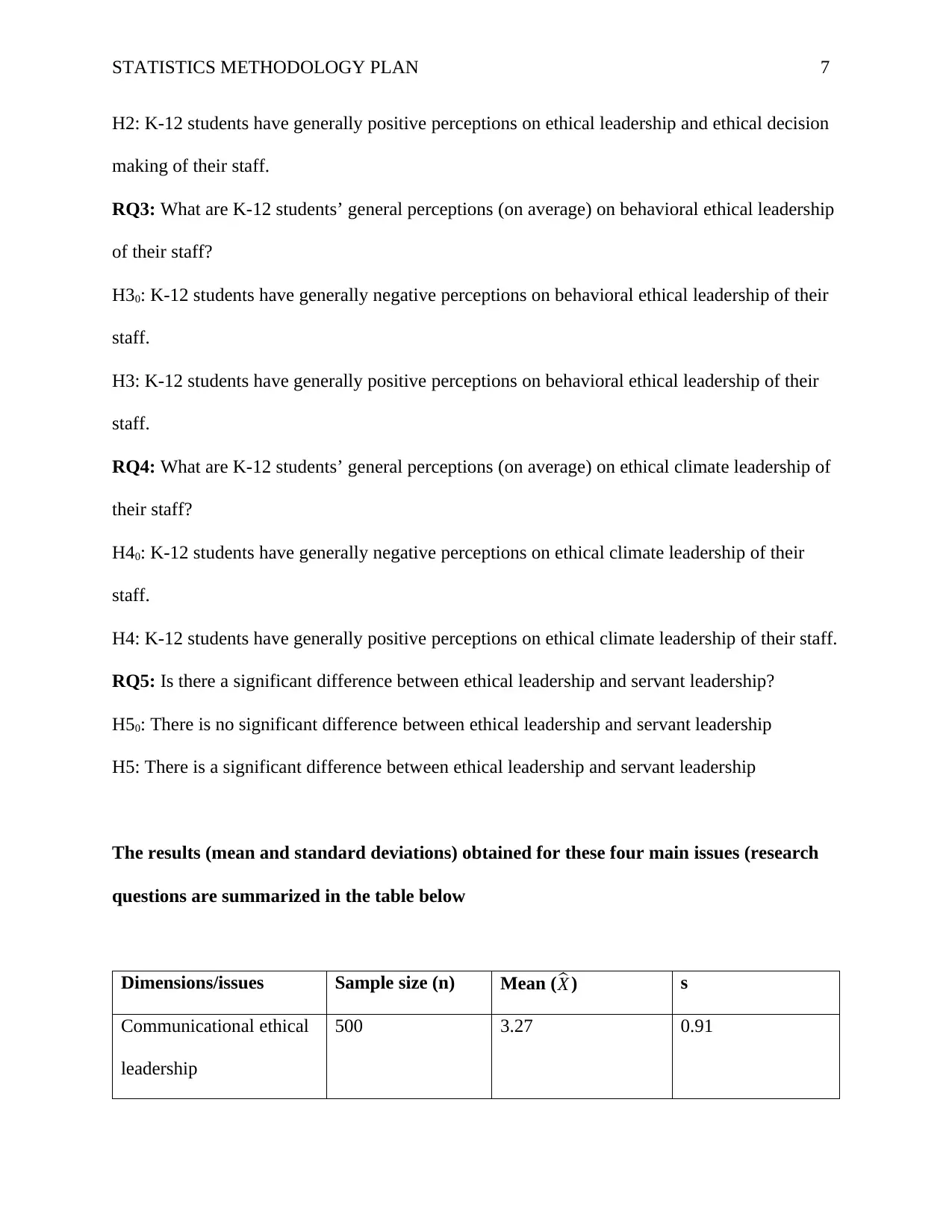
STATISTICS METHODOLOGY PLAN 7
H2: K-12 students have generally positive perceptions on ethical leadership and ethical decision
making of their staff.
RQ3: What are K-12 students’ general perceptions (on average) on behavioral ethical leadership
of their staff?
H30: K-12 students have generally negative perceptions on behavioral ethical leadership of their
staff.
H3: K-12 students have generally positive perceptions on behavioral ethical leadership of their
staff.
RQ4: What are K-12 students’ general perceptions (on average) on ethical climate leadership of
their staff?
H40: K-12 students have generally negative perceptions on ethical climate leadership of their
staff.
H4: K-12 students have generally positive perceptions on ethical climate leadership of their staff.
RQ5: Is there a significant difference between ethical leadership and servant leadership?
H50: There is no significant difference between ethical leadership and servant leadership
H5: There is a significant difference between ethical leadership and servant leadership
The results (mean and standard deviations) obtained for these four main issues (research
questions are summarized in the table below
Dimensions/issues Sample size (n) Mean ( ^X ) s
Communicational ethical
leadership
500 3.27 0.91
H2: K-12 students have generally positive perceptions on ethical leadership and ethical decision
making of their staff.
RQ3: What are K-12 students’ general perceptions (on average) on behavioral ethical leadership
of their staff?
H30: K-12 students have generally negative perceptions on behavioral ethical leadership of their
staff.
H3: K-12 students have generally positive perceptions on behavioral ethical leadership of their
staff.
RQ4: What are K-12 students’ general perceptions (on average) on ethical climate leadership of
their staff?
H40: K-12 students have generally negative perceptions on ethical climate leadership of their
staff.
H4: K-12 students have generally positive perceptions on ethical climate leadership of their staff.
RQ5: Is there a significant difference between ethical leadership and servant leadership?
H50: There is no significant difference between ethical leadership and servant leadership
H5: There is a significant difference between ethical leadership and servant leadership
The results (mean and standard deviations) obtained for these four main issues (research
questions are summarized in the table below
Dimensions/issues Sample size (n) Mean ( ^X ) s
Communicational ethical
leadership
500 3.27 0.91
Paraphrase This Document
Need a fresh take? Get an instant paraphrase of this document with our AI Paraphraser
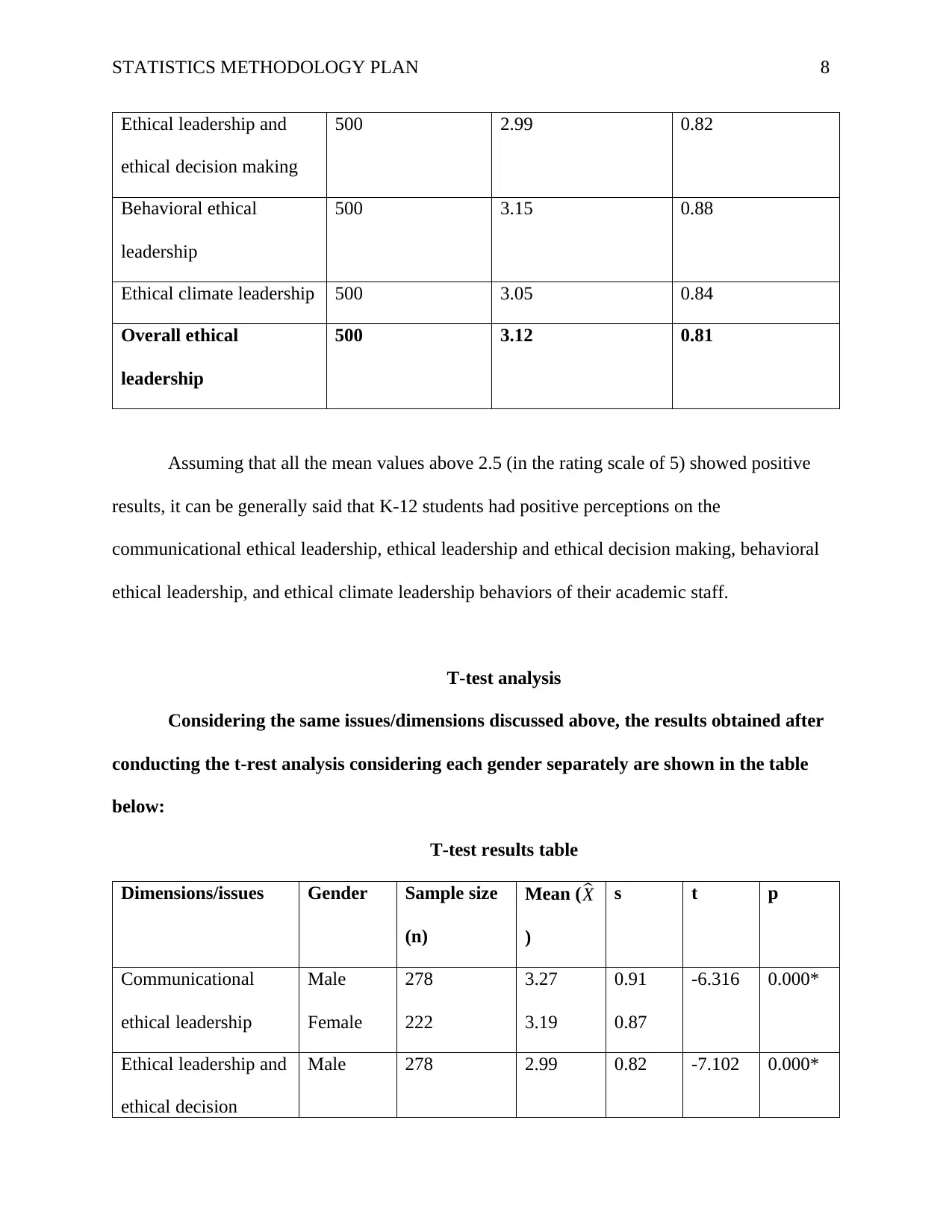
STATISTICS METHODOLOGY PLAN 8
Ethical leadership and
ethical decision making
500 2.99 0.82
Behavioral ethical
leadership
500 3.15 0.88
Ethical climate leadership 500 3.05 0.84
Overall ethical
leadership
500 3.12 0.81
Assuming that all the mean values above 2.5 (in the rating scale of 5) showed positive
results, it can be generally said that K-12 students had positive perceptions on the
communicational ethical leadership, ethical leadership and ethical decision making, behavioral
ethical leadership, and ethical climate leadership behaviors of their academic staff.
T-test analysis
Considering the same issues/dimensions discussed above, the results obtained after
conducting the t-rest analysis considering each gender separately are shown in the table
below:
T-test results table
Dimensions/issues Gender Sample size
(n)
Mean ( ^X
)
s t p
Communicational
ethical leadership
Male
Female
278
222
3.27
3.19
0.91
0.87
-6.316 0.000*
Ethical leadership and
ethical decision
Male 278 2.99 0.82 -7.102 0.000*
Ethical leadership and
ethical decision making
500 2.99 0.82
Behavioral ethical
leadership
500 3.15 0.88
Ethical climate leadership 500 3.05 0.84
Overall ethical
leadership
500 3.12 0.81
Assuming that all the mean values above 2.5 (in the rating scale of 5) showed positive
results, it can be generally said that K-12 students had positive perceptions on the
communicational ethical leadership, ethical leadership and ethical decision making, behavioral
ethical leadership, and ethical climate leadership behaviors of their academic staff.
T-test analysis
Considering the same issues/dimensions discussed above, the results obtained after
conducting the t-rest analysis considering each gender separately are shown in the table
below:
T-test results table
Dimensions/issues Gender Sample size
(n)
Mean ( ^X
)
s t p
Communicational
ethical leadership
Male
Female
278
222
3.27
3.19
0.91
0.87
-6.316 0.000*
Ethical leadership and
ethical decision
Male 278 2.99 0.82 -7.102 0.000*
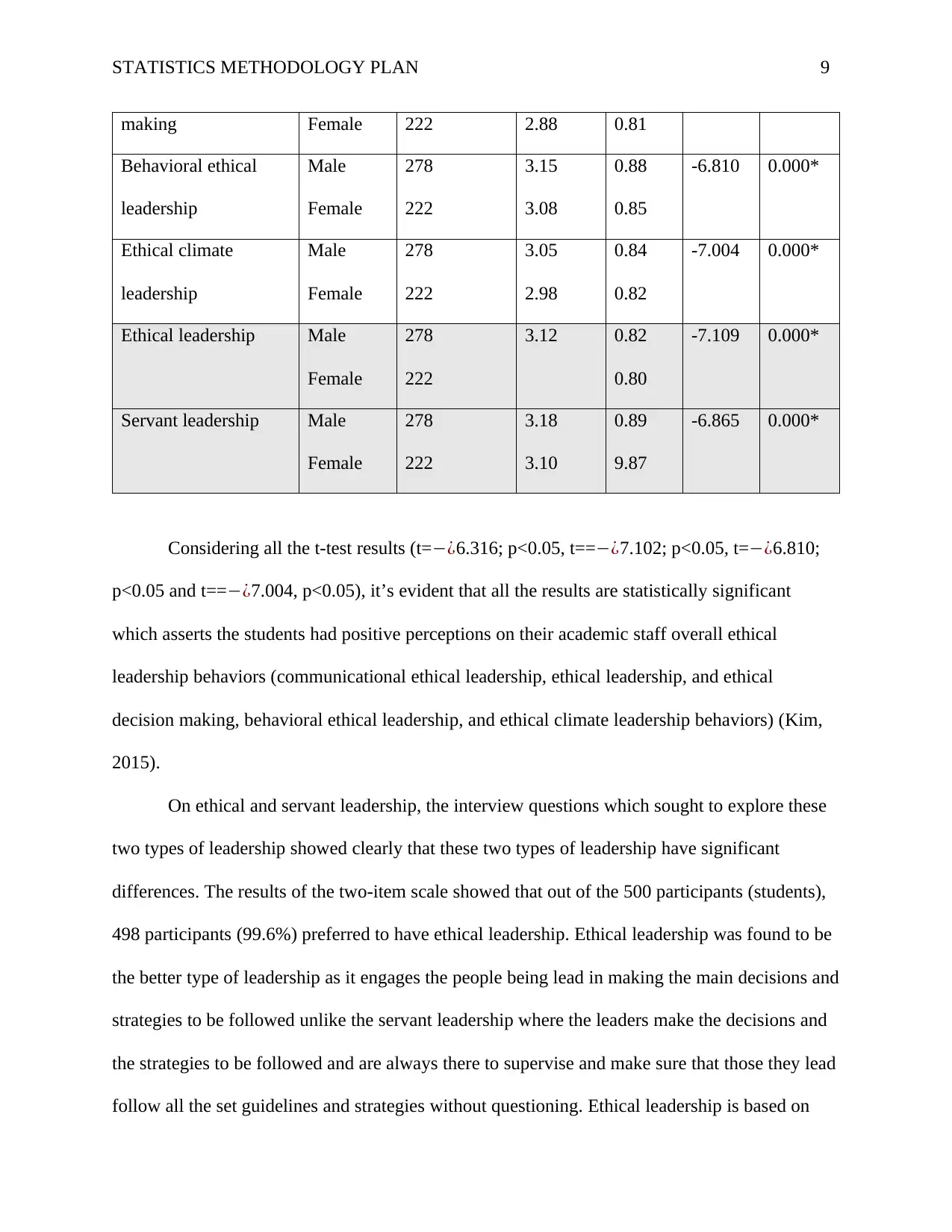
STATISTICS METHODOLOGY PLAN 9
making Female 222 2.88 0.81
Behavioral ethical
leadership
Male
Female
278
222
3.15
3.08
0.88
0.85
-6.810 0.000*
Ethical climate
leadership
Male
Female
278
222
3.05
2.98
0.84
0.82
-7.004 0.000*
Ethical leadership Male
Female
278
222
3.12 0.82
0.80
-7.109 0.000*
Servant leadership Male
Female
278
222
3.18
3.10
0.89
9.87
-6.865 0.000*
Considering all the t-test results (t=−¿6.316; p<0.05, t==−¿7.102; p<0.05, t=−¿6.810;
p<0.05 and t==−¿7.004, p<0.05), it’s evident that all the results are statistically significant
which asserts the students had positive perceptions on their academic staff overall ethical
leadership behaviors (communicational ethical leadership, ethical leadership, and ethical
decision making, behavioral ethical leadership, and ethical climate leadership behaviors) (Kim,
2015).
On ethical and servant leadership, the interview questions which sought to explore these
two types of leadership showed clearly that these two types of leadership have significant
differences. The results of the two-item scale showed that out of the 500 participants (students),
498 participants (99.6%) preferred to have ethical leadership. Ethical leadership was found to be
the better type of leadership as it engages the people being lead in making the main decisions and
strategies to be followed unlike the servant leadership where the leaders make the decisions and
the strategies to be followed and are always there to supervise and make sure that those they lead
follow all the set guidelines and strategies without questioning. Ethical leadership is based on
making Female 222 2.88 0.81
Behavioral ethical
leadership
Male
Female
278
222
3.15
3.08
0.88
0.85
-6.810 0.000*
Ethical climate
leadership
Male
Female
278
222
3.05
2.98
0.84
0.82
-7.004 0.000*
Ethical leadership Male
Female
278
222
3.12 0.82
0.80
-7.109 0.000*
Servant leadership Male
Female
278
222
3.18
3.10
0.89
9.87
-6.865 0.000*
Considering all the t-test results (t=−¿6.316; p<0.05, t==−¿7.102; p<0.05, t=−¿6.810;
p<0.05 and t==−¿7.004, p<0.05), it’s evident that all the results are statistically significant
which asserts the students had positive perceptions on their academic staff overall ethical
leadership behaviors (communicational ethical leadership, ethical leadership, and ethical
decision making, behavioral ethical leadership, and ethical climate leadership behaviors) (Kim,
2015).
On ethical and servant leadership, the interview questions which sought to explore these
two types of leadership showed clearly that these two types of leadership have significant
differences. The results of the two-item scale showed that out of the 500 participants (students),
498 participants (99.6%) preferred to have ethical leadership. Ethical leadership was found to be
the better type of leadership as it engages the people being lead in making the main decisions and
strategies to be followed unlike the servant leadership where the leaders make the decisions and
the strategies to be followed and are always there to supervise and make sure that those they lead
follow all the set guidelines and strategies without questioning. Ethical leadership is based on
⊘ This is a preview!⊘
Do you want full access?
Subscribe today to unlock all pages.

Trusted by 1+ million students worldwide
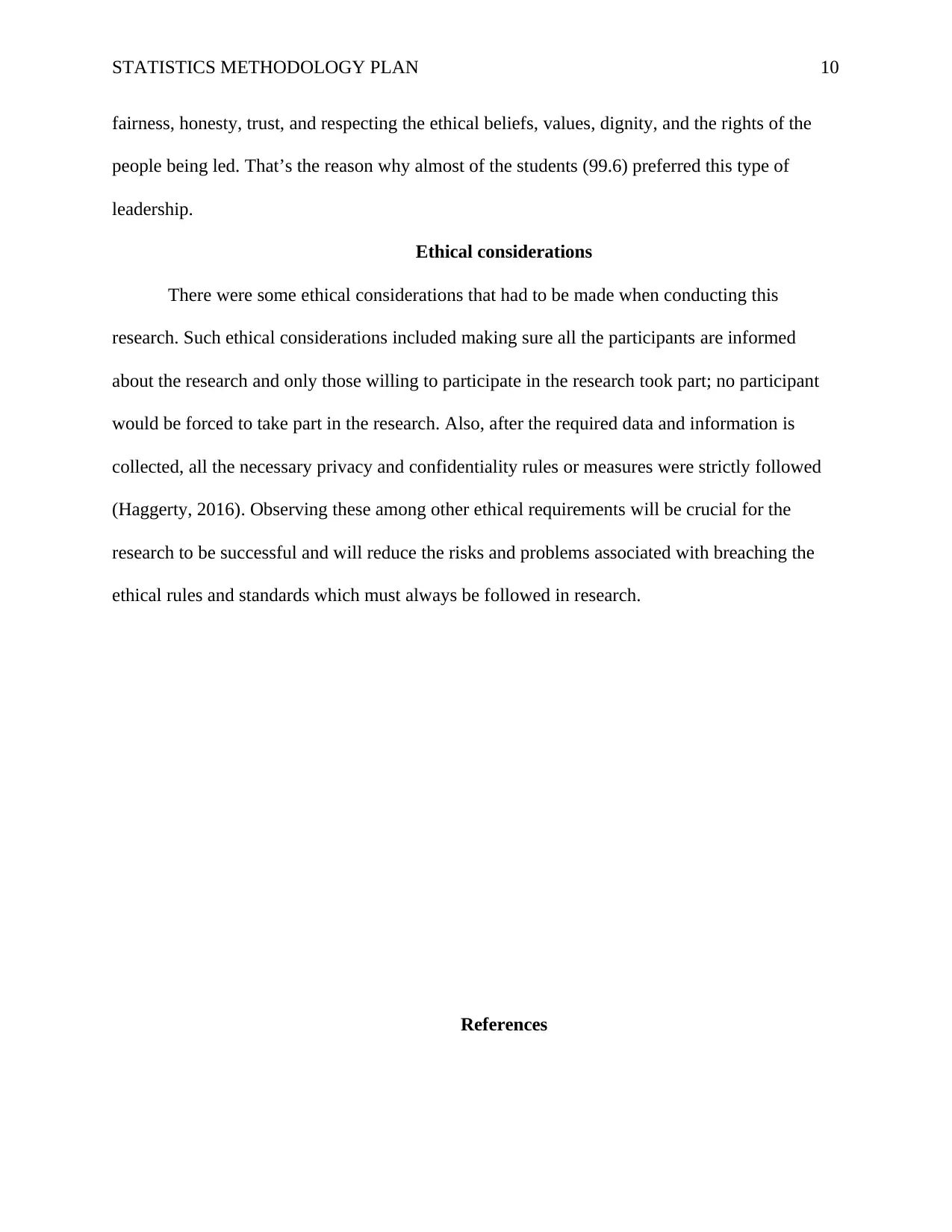
STATISTICS METHODOLOGY PLAN 10
fairness, honesty, trust, and respecting the ethical beliefs, values, dignity, and the rights of the
people being led. That’s the reason why almost of the students (99.6) preferred this type of
leadership.
Ethical considerations
There were some ethical considerations that had to be made when conducting this
research. Such ethical considerations included making sure all the participants are informed
about the research and only those willing to participate in the research took part; no participant
would be forced to take part in the research. Also, after the required data and information is
collected, all the necessary privacy and confidentiality rules or measures were strictly followed
(Haggerty, 2016). Observing these among other ethical requirements will be crucial for the
research to be successful and will reduce the risks and problems associated with breaching the
ethical rules and standards which must always be followed in research.
References
fairness, honesty, trust, and respecting the ethical beliefs, values, dignity, and the rights of the
people being led. That’s the reason why almost of the students (99.6) preferred this type of
leadership.
Ethical considerations
There were some ethical considerations that had to be made when conducting this
research. Such ethical considerations included making sure all the participants are informed
about the research and only those willing to participate in the research took part; no participant
would be forced to take part in the research. Also, after the required data and information is
collected, all the necessary privacy and confidentiality rules or measures were strictly followed
(Haggerty, 2016). Observing these among other ethical requirements will be crucial for the
research to be successful and will reduce the risks and problems associated with breaching the
ethical rules and standards which must always be followed in research.
References
Paraphrase This Document
Need a fresh take? Get an instant paraphrase of this document with our AI Paraphraser
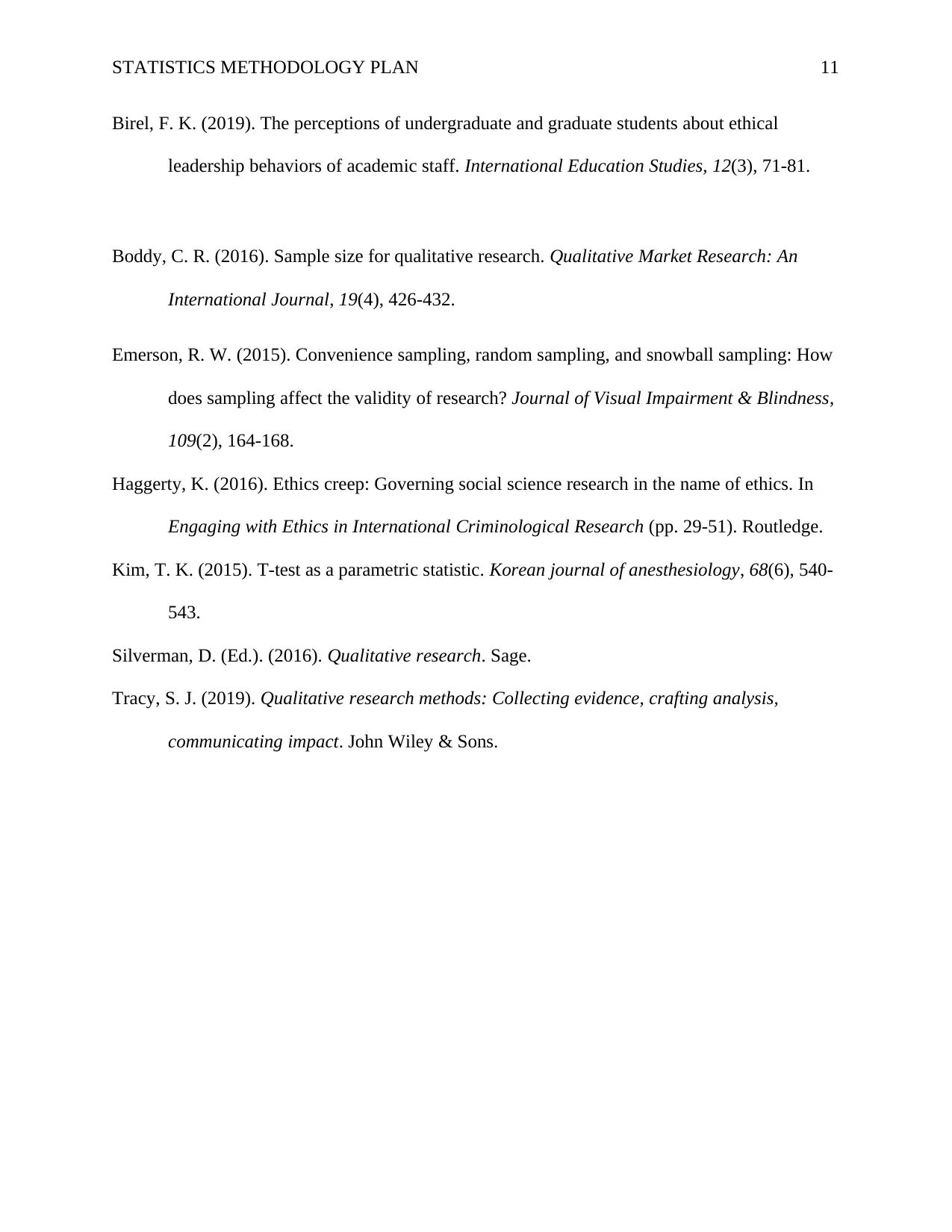
STATISTICS METHODOLOGY PLAN 11
Birel, F. K. (2019). The perceptions of undergraduate and graduate students about ethical
leadership behaviors of academic staff. International Education Studies, 12(3), 71-81.
Boddy, C. R. (2016). Sample size for qualitative research. Qualitative Market Research: An
International Journal, 19(4), 426-432.
Emerson, R. W. (2015). Convenience sampling, random sampling, and snowball sampling: How
does sampling affect the validity of research? Journal of Visual Impairment & Blindness,
109(2), 164-168.
Haggerty, K. (2016). Ethics creep: Governing social science research in the name of ethics. In
Engaging with Ethics in International Criminological Research (pp. 29-51). Routledge.
Kim, T. K. (2015). T-test as a parametric statistic. Korean journal of anesthesiology, 68(6), 540-
543.
Silverman, D. (Ed.). (2016). Qualitative research. Sage.
Tracy, S. J. (2019). Qualitative research methods: Collecting evidence, crafting analysis,
communicating impact. John Wiley & Sons.
Birel, F. K. (2019). The perceptions of undergraduate and graduate students about ethical
leadership behaviors of academic staff. International Education Studies, 12(3), 71-81.
Boddy, C. R. (2016). Sample size for qualitative research. Qualitative Market Research: An
International Journal, 19(4), 426-432.
Emerson, R. W. (2015). Convenience sampling, random sampling, and snowball sampling: How
does sampling affect the validity of research? Journal of Visual Impairment & Blindness,
109(2), 164-168.
Haggerty, K. (2016). Ethics creep: Governing social science research in the name of ethics. In
Engaging with Ethics in International Criminological Research (pp. 29-51). Routledge.
Kim, T. K. (2015). T-test as a parametric statistic. Korean journal of anesthesiology, 68(6), 540-
543.
Silverman, D. (Ed.). (2016). Qualitative research. Sage.
Tracy, S. J. (2019). Qualitative research methods: Collecting evidence, crafting analysis,
communicating impact. John Wiley & Sons.
1 out of 11
Related Documents
Your All-in-One AI-Powered Toolkit for Academic Success.
+13062052269
info@desklib.com
Available 24*7 on WhatsApp / Email
![[object Object]](/_next/static/media/star-bottom.7253800d.svg)
Unlock your academic potential
Copyright © 2020–2025 A2Z Services. All Rights Reserved. Developed and managed by ZUCOL.




